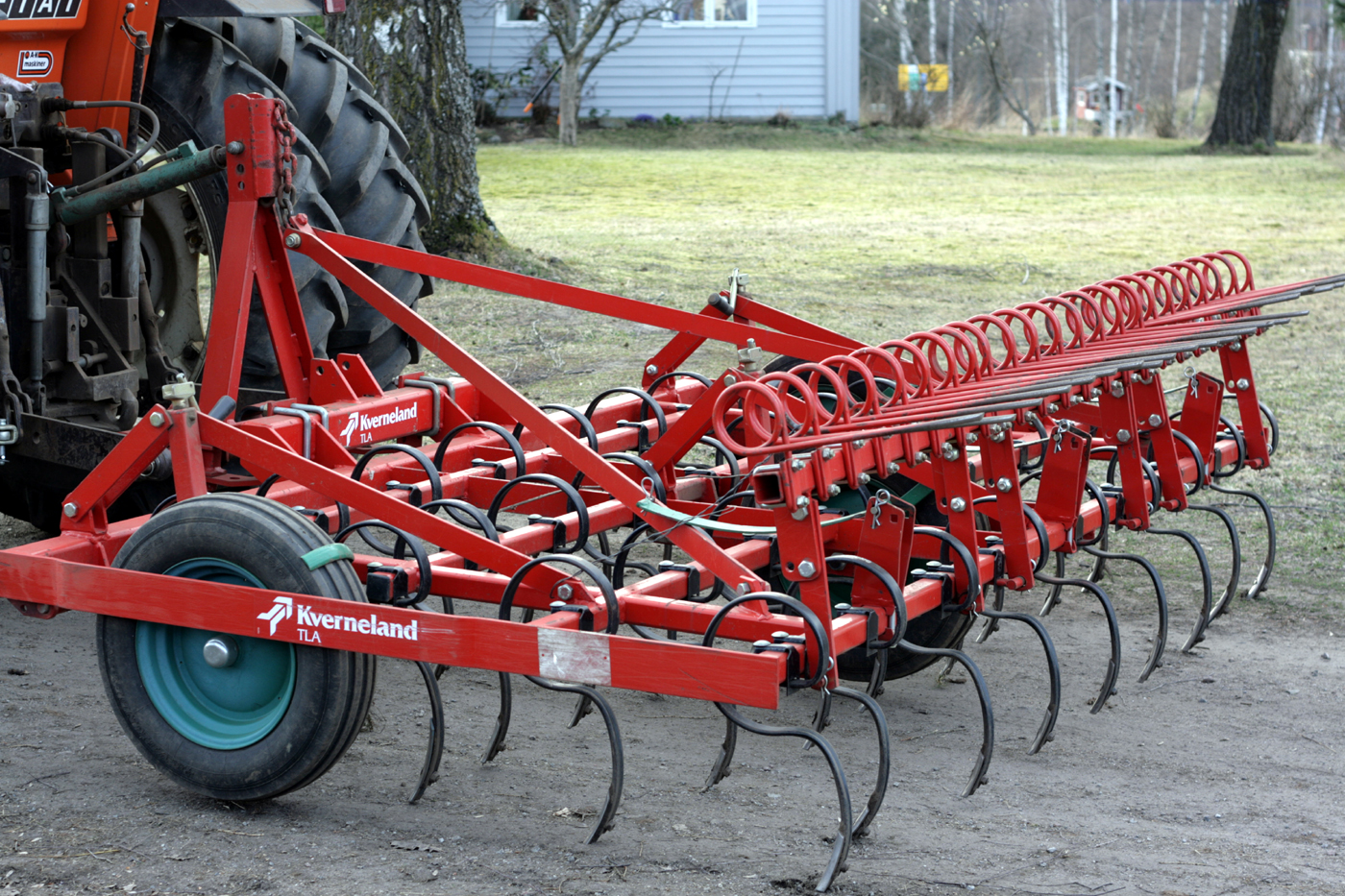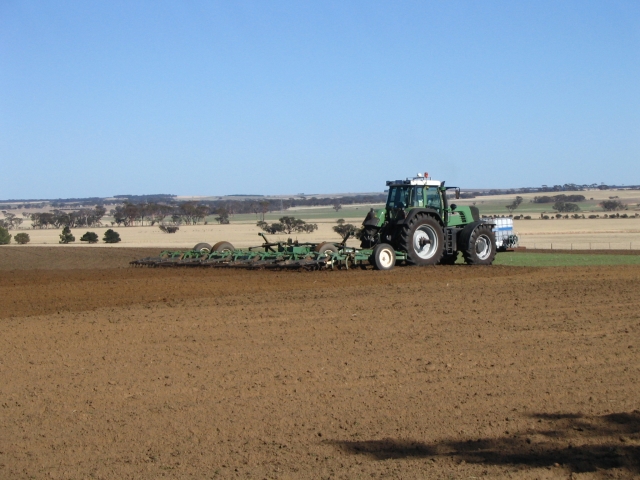|
Harrows
In agriculture, a harrow is a farm implement used for surface tillage. It is used after ploughing for breaking up and smoothing out the surface of the soil. The purpose of harrowing is to break up clods and to provide a soil structure, called tilth, that is suitable for planting seeds. Coarser harrowing may also be used to remove weeds and to cover seed after sowing. Harrows differ from ploughs, which cut the upper 12 to 25 centimetre (5 to 10 in) layer of soil, and leave furrows, parallel trenches. Harrows differ from cultivators in that they disturb the whole surface of the soil, while a cultivator instead disturbs only narrow tracks between the crop rows to kill weeds. There are four general types of harrows: disc harrows, tine harrows (including spring-tooth harrows, drag harrows, and spike harrows), chain harrows, and chain-disk harrows. Harrows were originally drawn by draft animals, such as horses, mules, or oxen, or in some times and places by manual labourers. In ... [...More Info...] [...Related Items...] OR: [Wikipedia] [Google] [Baidu] |
Disc Harrow
A disc harrow is a harrow whose cutting edges are a row of concave metal discs, which may be scalloped or set at an oblique angle. It is an agricultural implement that is used to till the soil where crops are to be planted. It is also used to chop up unwanted weeds or crop residue. It consists of many carbon steel discs, and sometimes longer-lasting boron steel discs, which have many varying concavities and disc blade sizes and spacing (the choices of the latter being determined by the final result required in a given soil type) and which are arranged into two sections ("offset disc harrow") or four sections ("tandem disc harrow"). When viewed from above, the four sections would appear to form an "X" which has been flattened to be wider than it is tall. The discs are also offset so that they are not parallel with the overall direction of the implement. This arrangement ensures that the discs will repeatedly slice any ground to which they are applied, in order to optimize the ... [...More Info...] [...Related Items...] OR: [Wikipedia] [Google] [Baidu] |
Drag Harrow
A drag harrow, a type of spring-tooth harrow, is a largely outdated type of soil cultivation implement that is used to smooth the ground as well as loosen it after it has been plowed and packed. It uses many flexible iron teeth usually arranged into three rows. It has no hydraulic functionality and has to be raised/adjusted with one or multiple manual levers. It is a largely outdated piece of farm equipment, having been replaced by more modern disc harrows and hydraulically operated field cultivators. Uses A drag harrow is used to loosen and even out soil after it has been plowed and packed. It pulls up large rocks which may then be picked up manually and put in the tractor's stone box to remove from the field. The drag harrow also kills some weeds that may be present, but it is not very efficient in doing so due to its highly flexible teeth, hence it is not one of its primary functions. In modern times The drag harrow is not often used in modern farming as other harr ... [...More Info...] [...Related Items...] OR: [Wikipedia] [Google] [Baidu] |
Spring-tooth Harrow
A spring-tooth harrow, sometimes called a drag harrow, is a type of harrow, and specifically a type of tine harrow. It is a largely outdated piece of farm equipment. It uses many flexible iron teeth mounted in rows to loosen the soil before planting. It is set in the ground and raised manually and cannot be backed up; this is why it has been replaced by more modern equipment such as the chisel plow and field cultivator. A drag harrow more specifically refers to a largely outdated type of soil cultivation implement that is used to smooth the ground as well as loosen it after it has been plowed and packed. It uses many flexible iron teeth usually arranged into three rows. It has no hydraulic functionality and has to be raised/adjusted with one or multiple manual levers. It is a largely outdated piece of farm equipment, having been replaced by more modern disc harrows and deeper, stiff-toothed rippers, however, smaller farmers still use them. Uses A drag harrow is used to l ... [...More Info...] [...Related Items...] OR: [Wikipedia] [Google] [Baidu] |
Cultivator
A cultivator is a piece of agricultural equipment used for secondary tillage. One sense of the name refers to frames with ''teeth'' (also called ''shanks'') that pierce the soil as they are dragged through it linearly. It also refers to machines that use rotary motion of disks or teeth to accomplish a similar result. The rotary tiller is a principal example. Cultivators stir and pulverize the soil, either before planting (to aerate the soil and prepare a smooth, loose seedbed) or after the crop has begun growing (to kill weeds—controlled disturbance of the topsoil close to the crop plants kills the surrounding weeds by uprooting them, burying their leaves to disrupt their photosynthesis, or a combination of both). Unlike a harrow, which disturbs the entire surface of the soil, cultivators are designed to disturb the soil in careful patterns, sparing the crop plants but disrupting the weeds. Cultivators of the toothed type are often similar in form to chisel plows, b ... [...More Info...] [...Related Items...] OR: [Wikipedia] [Google] [Baidu] |
Tillage
Tillage is the agricultural preparation of soil by mechanical agitation of various types, such as digging, stirring, and overturning. Examples of human-powered tilling methods using hand tools include shoveling, picking, mattock work, hoeing, and raking. Examples of draft-animal-powered or mechanized work include ploughing (overturning with moldboards or chiseling with chisel shanks), rototilling, rolling with cultipackers or other rollers, harrowing, and cultivating with cultivator shanks (teeth). Tillage that is deeper and more thorough is classified as primary, and tillage that is shallower and sometimes more selective of location is secondary. Primary tillage such as ploughing tends to produce a rough surface finish, whereas secondary tillage tends to produce a smoother surface finish, such as that required to make a good seedbed for many crops. Harrowing and rototilling often combine primary and secondary tillage into one operation. "Tillage" can also mean ... [...More Info...] [...Related Items...] OR: [Wikipedia] [Google] [Baidu] |
Seedbed
A seedbed or seedling bed is the local soil environment in which seeds are planted. Often it comprises not only the soil but also a specially prepared cold frame, hotbed or raised bed used to grow the seedlings in a controlled environment into larger young plants before transplanting them into a garden or field. A seedling bed is used to increase the number of seeds that germinate. Soil type The soil of a seedbed needs to be loose and smoothed, without large lumps. These traits are needed so that seeds can be planted easily, and at a specific depth for best germination. Large lumps and uneven surface would tend to make the planting depth random. Many types of seedlings also need loose soil with minimal rocky content for best conditions to grow their roots. (For example, carrots grown in rocky soil will tend not to grow straight.) Seedbed preparation Seedbed preparation in farm fields often involves secondary tillage via harrows and cultivators. This may follow primary tillage ... [...More Info...] [...Related Items...] OR: [Wikipedia] [Google] [Baidu] |
Cultivator
A cultivator is a piece of agricultural equipment used for secondary tillage. One sense of the name refers to frames with ''teeth'' (also called ''shanks'') that pierce the soil as they are dragged through it linearly. It also refers to machines that use rotary motion of disks or teeth to accomplish a similar result. The rotary tiller is a principal example. Cultivators stir and pulverize the soil, either before planting (to aerate the soil and prepare a smooth, loose seedbed) or after the crop has begun growing (to kill weeds—controlled disturbance of the topsoil close to the crop plants kills the surrounding weeds by uprooting them, burying their leaves to disrupt their photosynthesis, or a combination of both). Unlike a harrow, which disturbs the entire surface of the soil, cultivators are designed to disturb the soil in careful patterns, sparing the crop plants but disrupting the weeds. Cultivators of the toothed type are often similar in form to chisel plows, b ... [...More Info...] [...Related Items...] OR: [Wikipedia] [Google] [Baidu] |
Roller (agricultural Tool)
The roller is an agricultural tool used for flattening land or breaking up large clumps of soil, especially after ploughing or disc harrowing. Typically, rollers are pulled by tractors or, prior to mechanisation, a team of animals such as horses or oxen. As well as for agricultural purposes, rollers are used on cricket pitches and residential lawn areas. Flatter land makes subsequent weed control and harvesting easier, and rolling can help to reduce moisture loss from cultivated soil. On lawns, rolling levels the land for mowing and compacts the soil surface. Rollers may be weighted in different ways. For many uses a heavy roller is used. These may consist of one or more cylinders made of thick steel, a thinner steel cylinder filled with concrete, or a cylinder filled with water. A water-filled roller has the advantage that the water may be drained out for lighter use or for transport. In frost-prone areas a water filled roller must be drained for winter storage to avoid ... [...More Info...] [...Related Items...] OR: [Wikipedia] [Google] [Baidu] |
Man Harrowing With Tractor And Disk Harrow (1295027)
A man is an adult male human. Prior to adulthood, a male human is referred to as a boy (a male child or adolescent). Like most other male mammals, a man's genome usually inherits an X chromosome from the mother and a Y chromosome from the father. Sex differentiation of the male fetus is governed by the SRY gene on the Y chromosome. During puberty, hormones which stimulate androgen production result in the development of secondary sexual characteristics, thus exhibiting greater differences between the sexes. These include greater muscle mass, the growth of facial hair and a lower body fat composition. Male anatomy is distinguished from female anatomy by the male reproductive system, which includes the penis, testicles, sperm duct, prostate gland and the epididymis, and by secondary sex characteristics, including a narrower pelvis, narrower hips, and smaller breasts without mammary glands. Throughout human history, traditional gender roles have often defined ... [...More Info...] [...Related Items...] OR: [Wikipedia] [Google] [Baidu] |







.jpg)